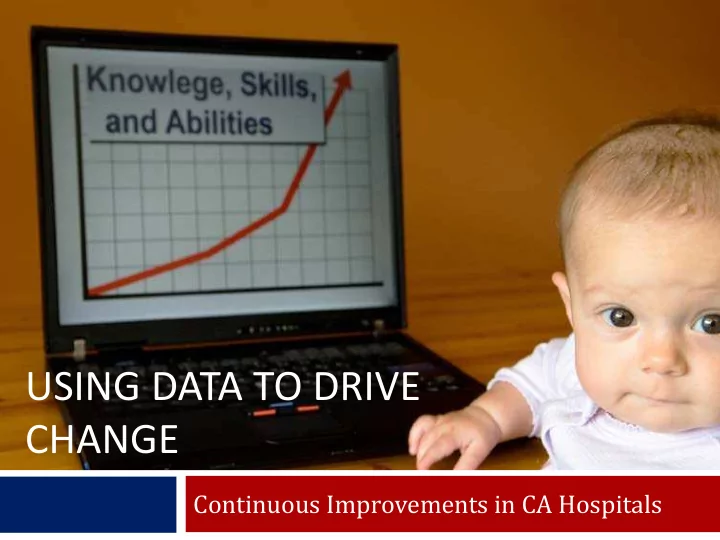

USING DATA TO DRIVE CHANGE Continuous Improvements in CA Hospitals
California Breastfeeding and Hospital Performance Reports 2006‐2015 Produced by: California WIC Association and UCD Human Lactation Center 2016 Report Includes: Full Report California Fact Sheet County Fact Sheets
Using Data to Drive Change Evidence needed for policy change Data can highlight disparities Data needed to obtain administrative support Data used as goals and to demonstrate progress Data can be used to fight misinformation
Using Data to Support BF Public surveillance and reporting Highlighting data for the media Finding focus areas Working with others Demonstrating change is possible
In‐Hospital Breastfeeding (BF) Data Blood sample taken in all CA maternity hospitals for newborn screening program Mothers asked what babies fed since birth: Only human milk Only formula Human milk and formula Data reported by CDPH Maternal Child and Adolescent Health Program
California In-hospital Breastfeeding Genetic Disease Screening Data Rates
“The Gap” 100 95.1 93.9 93.8 89.4 90 80 68.6 67.1 70 60.2 59.4 60 Percent 50 40 30 20 10 0 California Kern Los Angeles Orange Any Exclusive
Statewide Exclusive Breastfeeding 2015 68.6% 2010 56.6% CDPH Genetic Disease Screening Data
In-Hospital Breastfeeding by Ethnicity (2010) 100 93.4 92.7 91 90.5 87.2 86.9 84.8 90 80 80 73.8 66.5 70 60.3 56.8 55.9 60 Percent 49.8 48.3 46.1 50 40 30 20 10 0 White Asian Hispanic Multiple American Other Pacific African Indian Islander American Any Excl CDPH Genetic Disease Screening Data
In-Hospital Breastfeeding by Ethnicity (2015) 95.3 95.3 100 94.1 93.8 91.6 89 88.2 85.3 90 81.4 77.1 80 71.9 70 64.2 64.3 63.4 60.7 57.9 60 Percent 50 40 30 20 10 0 White Asian Hispanic Multiple American Other Pacific African Indian Islander American Any Exclusive CDPH Genetic Disease Screening Data
Change in EBF (2010 – 2015) 100 90 81.4 77.1 80 73.8 71.9 66.5 70 64.2 64.3 63.4 60.7 60.3 57.9 56.8 60 55.9 Percent 49.8 48.3 50 46.1 40 30 20 10 0 White Asian Hispanic Multiple American Other Pacific African Indian Islander American 2010 2015 CDPH Genetic Disease Screening Data
Regional Disparities Persist Highest BF rates in • northern, mountain, and coastal areas Lowest rates in • southern and central valley areas Efforts by local • coalitions, First 5, and other funders are closing the gaps
Exclusive Breastfeeding By County (2010‐15) 2010 2015 70 60.7 60.2 59.4 60 50 43.3 39.3 Percent 36.9 40 35.9 30 19.2 20 10 0 Imperial Kern Los Angeles San Joaquin CDPH Genetic Disease Screening Data
The “Good List” Highest 10 (2015) Any Excl 100 90 80 70 60 Percent 50 40 30 20 10 0 1 2 3 4 5 6 7 8 9 10 CDPH Genetic Disease Screening Data
The “Bad List” Lowest 10 (2015) Any Excl 100 90 80 70 60 50 40 30 20 10 0 1 2 3 4 5 6 7 8 9 10 CDPH Genetic Disease Screening Data
Total Number of CA Baby Friendly Hospitals by Year 90 80 70 60 Number 50 40 30 20 10 0 <2000 2002 2004 2006 2008 2010 2012 2014 2016 Year
California Uses Data to Drive Change Surveillance data rarely available at hospital level Focus on exclusive breastfeeding and “gap” CA has 22% of all US Baby Friendly Hospitals Other states look to us
Gaps in Data after Discharge Success has been driven by nearly universal public in-hospital data Similar data not available to improve BF rates after discharge Federal and other sources are limited and collected in different ways at different time points Consistent and comparable data are needed to build on success and improve maternal child health
What’s in the Report? Describes how data have been used a local, regional, and national levels to drive change Describes benefits and challenges of using surveillance data Describes successful use of data and need for consistent and comparable data after discharge Includes recommendations for data collection and other efforts to build on momentum
What’s in the Fact Sheets? County Fact Sheets State Fact Sheet Provides connection between Provides same background as hospital policies and BF rates country sheets Compares hospitals side by Statewide any and excl BF side rates by race/ethnicity Describes how data have been used to drive change in CA Detailed information about Includes county rates and data collection and the “lists” rank, lists Baby Friendly and County rankings, top 15, any state-level highest performing hospitals (if bottom 15, maps showing present), and the highest regional changes in rates performing hospital in the Recommendations county (even if not on lists)
For More Information California WIC UC Davis Human Association Lactation Center Sarah Diaz Dr. Jane Heinig 530-750-2280 530-754-5364 sdiaz@calwic.org mjheinig@ucdavis.edu QUESTIONS??????
Recommend
More recommend